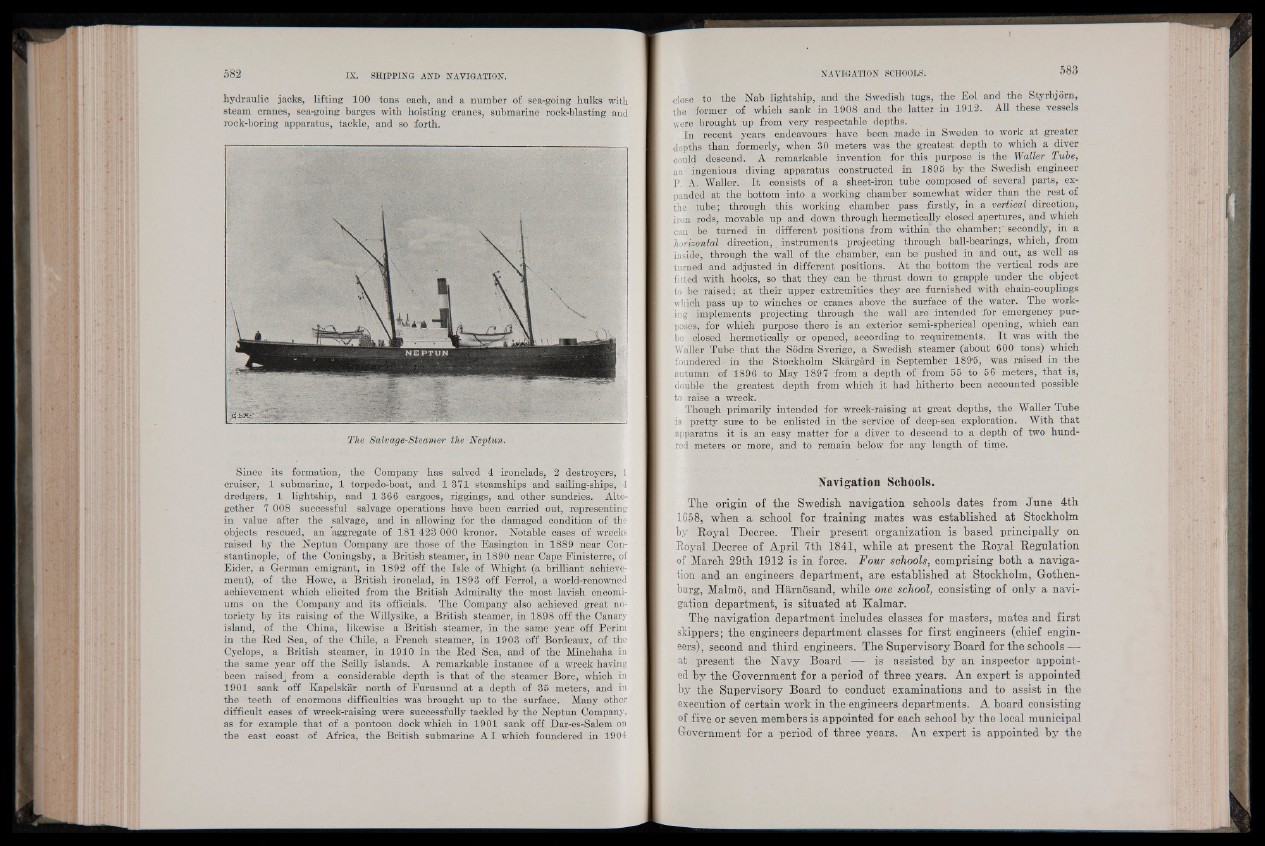
hydraulic jacks, lifting 100 tons each, and a number of sea-going hulks with
steam cranes, sea-going barges with hoisting cranes, submarine rock-blasting and
rock-boring apparatus, tackle, and so forth.
The Salvage-Steamer the Neptun.
Since its formation, the Company has salved 4 ironclads, 2 destroyers,:-1
cruiser, 1 submarine, 1 torpedo-boat, and 1 371 steamships and sailing-ships,i 4
dredgers, 1 lightship, and 1 366 cargoes, riggings, and other sundries. Altogether
7 008 successful salvage operations Have been carried out, representing
in value after the salvage, and in allowing for the damaged condition of- the
objects rescued, an aggregate of 181 423 000 kronor. Notable cases of wrecks
raised by the Neptun Company are those of the Easington in 1889 near Constantinople,
of the Coningsby, a British steamer, in 1890 near Cape Finisterre, of
Eider, a German emigrant, in 1892 off the Isle of Whight (a brilliant achievement),
of the Howe, a British ironclad, in 1893 off Ferrol, a world-renowned
achievement which elicited from the British Admiralty the most lavish encomiums
on the Company and its officials. The Company also achieved great notoriety
by its raising of the Willysike, a British steamer, in 1898 off the Canary
island, of the China, likewise a British steamer, in the same year off Perim
in the Bed Sea, of the Chile, a French steamer, in 1903 off Bordeaux, of the
Cyclops, a British steamer, in 1910 in the Bed Sea, and of the Minehaha in
the same year off the Scilly islands. A remarkable instance of a wreck having
been raisedj from a considerable depth is that of the steamer Bore, which in
1901 sank off Kapelskar north of Furusund at a depth of 35 meters, and in
the teeth of enormous difficulties was brought up to the surface. Many other
difficult cases of wreck-raising were successfully tackled by the Neptun Company,
as for example that of a pontoon dock which in 1901 sank off Dar-es-Salem on
the east coast of Africa, the British submarine A I which foundered in 1904
close to the Nab lightship, and the Swedish tugs, the Eol and the Styrbjorn,
the former of which sank in 1908 and the latter in 1912. All these vessels
were brought up from very respectable depths.
In recent years endeavours—have been.made in Sweden to work at greater
depths than formerly, when 30 meters was the greatest depth to which a diver
could descend. A remarkable invention for this purpose is the Waller Tube,
an ¿ingenious diving apparatus constructed in 1895 by the Swedish engineer
P. A. Waller. I t consists of a sheet-iron tube composed of several parts, expanded
at the bottom into a working chamber somewhat wider than the rest of
the tube; through this working chamber pass firstly, in a vertical direction,
iron rods, movable up and down through hermetically closed apertures, and which
can’ be turned in different positions from within the chamber;'secondly, in a
horizontal direction, instruments projecting through ball-bearings, which, from
inside, through the wall of the chamber, can be pushed in and out, as well as
turned and adjusted in different positions. At the_ bottom the vertical rods are
fitted with hooks, so th a t they can be thrust down to grapple under the object
to be raised; at their upper extremities they are furnished with chain-eouplings
which pass up to winches or cranes above the surface of the water. The working,
implements projecting through the wall are intended for emergency purposes,
for which purpose there is an exterior semi-spherical opening, which can
.¿be* closed hermetically or opened, according to requirements. I t was with the
Waller Tube th a t the Sodra Sverige, a Swedish steamer (about 600 tons) which
foundered- in the Stockholm Skargard in September 1896, was raised in the
autumn of 1896 to May 1897 from a depth of from 55 to 56 meters, that is,
double the greatest depth from which it had hitherto been accounted possible
to raise a wreck.
Though primarily intended for wreck-raising at great depths, the Waller Tube
is pretty sure to be enlisted in the service of deep-sea exploration. With that
apparatus it is an easy matter for a diver to descend to a depth of two hundred
meters or more, and to remain below for any length of time.
Navigation Schools.
The origin of the Swedish navigation schools dates from June 4th
1658, when a school for training mates was established at Stockholm
by Royal Decree. Their present organization is based principally on
Royal Decree of April 7th 1841, while at present the Royal Regulation
of March 29th 1912 is in force. Four schools, comprising both a navigation
and an engineers department, are established at Stockholm, Gothenburg,
Malmo, and Harnosand, while one school, consisting of only a navigation
department, is situated at Kalmar.
The navigation department includes classes for masters, mates and first
skippers; the engineers department classes for first engineers (chief engineers),
second and third engineers. The Supervisory Board for the schools —
at present the Navy Board^^fflis assisted by an inspector appointed
by the Government for a period of three years. An expert is appointed
by the Supervisory Board to conduct examinations and to assist in the
execution of certain work in the engineers departments. A board consisting
of five or seven members is appointed for each school by the local municipal
Government for a period of three years. An expert is appointed by the